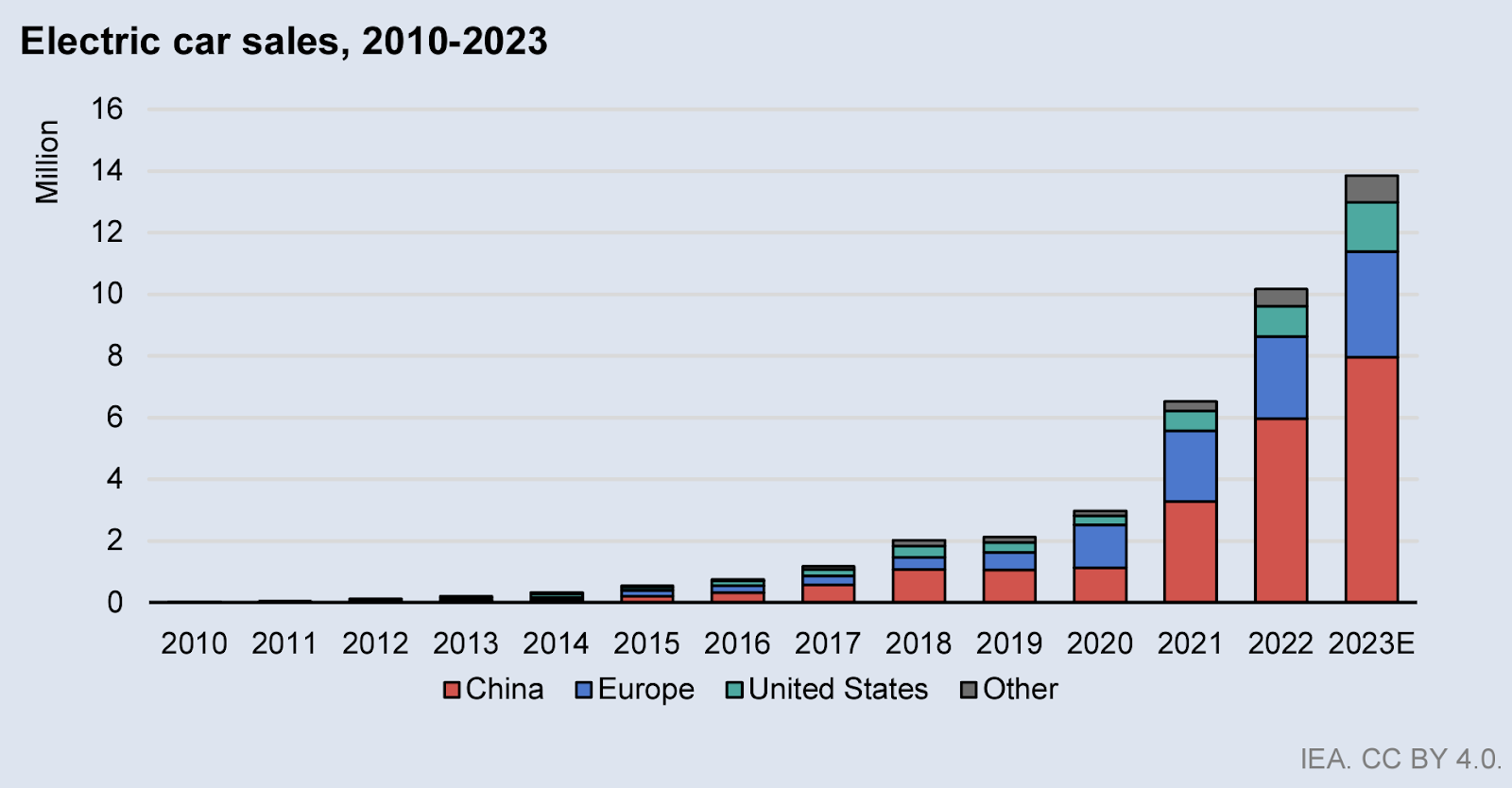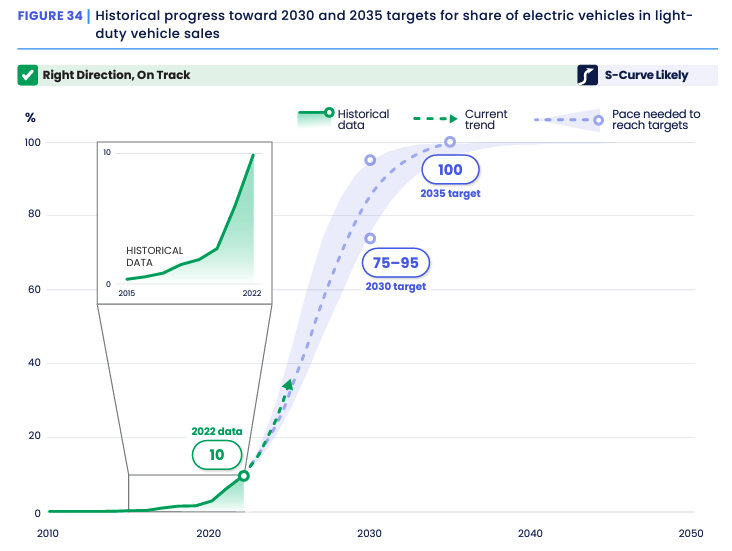There is, it appears, precisely one thing we are prepared to do at a scale commensurate with the climate crisis — buy cool cars.
This year’s UN climate confab is scheduled to be a “global stocktake” and it will surprise absolutely no one that action remains “woefully inadequate.” Global efforts “are failing across the board,” according to a group of the most spreadsheet-savvy folks in the field.
The group is called the Systems Change Lab, a joint effort of Climate Action Tracker, Climate Analytics, NewClimate Institute, ClimateWorks Foundation, the UN Climate Change High-Level Champions, Bezos Earth Fund, and World Resources Institute.
The Excel experts got together to map what needs doing to meet the Paris targets and distilled it all into 42 distinct categories. On 41 of them, the world is “off track.” Half are “well off track,” while six are heading in the wrong direction altogether.
One lonely indicator is on track and headed in the right direction — sales of electric cars.
Climate activists will be quick to remind us that buying more EVs is not a climate panacea. We have to tackle those other 41 categories as well (and maybe even deeper challenges). But it’s worth looking at this one green glimmer on the spreadsheets because EVs are not only popular but have become both a symbol and a heuristic, a kind of mental model illustrating the task of switching from fossil fuels to clean electricity.
And they are proliferating exponentially. Much faster than most people in most Canadian provinces would realize. From “the car of the uber rich to the car of the Uber driver” (a memorable line from journalist Akshat Rathi, host of the podcast Zero). If you lump together pure electric vehicles and plug-in hybrids, EVs already account for nearly one-in-five new cars sold around the world.
Just like heat pumps, the runaway leader is Norway. Today, almost all new cars have a plug. The speed has been astonishing. Only 12 years ago, EVs were less than one per cent.
“This market is kind of done,” said Colin McKerracher on a recent episode of Zero. A University of British Columbia graduate, McKerracher is now head of advanced transport for Bloomberg New Energy Finance. In Norway, says McKerracher “We're now just waiting for the fleet to turn over.”
And that’s a key point. The atmosphere doesn’t pay attention to our sales stats, only to the amount of fossil fuels we’ve burned. EVs can’t do anything about the amount of carbon already in the sky but in Norway, they are starting to make a dent in the amount going forward — 24 per cent of the fleet is now fully electric, another seven per cent plug-in hybrid, so Norway is close to electrifying one-third of the passenger vehicles on its roads.
The runners-up in terms of EV sales are also northern European: Over half in Iceland, while Sweden is over 44 per cent pure EVs (another 19 per cent plug-in hybrids) and the Netherlands around 29 per cent (plus another 13 per cent for PHEVs).
In North America, California is in the lead — in the first half of this year, one-quarter of new cars were EVs.
The latest figures for Canada show around 10 per cent for pure EVs and another three per cent for plug-in hybrids.
Very few westerners have grasped what’s going on in the world’s largest car market. China added 5.4 million EVs just in the first three quarters of this year. It is such a massive market and EVs are taking off so quickly that China accounts for 60 per cent of global electric car sales.
What’s particularly surprising is that the exponential growth has continued, even though China ended its subsidy program in 2022, reckoning it had passed the tipping point for momentum.
September figures show fully electric models rose to 25 per cent of sales in China. Add on the plug-in hybrids and EVs have taken 37 per cent of the market. The four top-selling cars of any kind are all EVs, with the bestselling fossil fuel-burner ranking fifth. And beyond its borders, China’s EV boom has made it the world’s biggest exporter of cars, overtaking Japan this year.
Globally, the rise of electric vehicles is beginning to look like a classic case of the exponential growth we’ve come to know so well from smartphones and other pandemics.
 Figure from the International Energy Agency, Global EV Outlook 2023
Figure from the International Energy Agency, Global EV Outlook 2023
And if growth continues, the analysts predict it will follow the classic “S-curve” for adoption, where a new product struggles along and then suddenly takes over. That’s why the Systems Change Lab rates EV sales as the one indicator out of 42 that’s heading in the “right direction, on track.”
 Figure from Systems Change Lab, State of Climate Action 2023
Figure from Systems Change Lab, State of Climate Action 2023
The story of EVs is fascinating, encompassing almost every aspect of the climate era: corporate shithousery and determined visionaries. Clever policies and political obstruction. Fear of climate disruption and demands for cleaner air. Carbon pricing, citizen pressure and consumer action, along with credit-trading, subsidies and myriad incentives. Governments around the world are introducing mandates to phase in zero-emission vehicles and phase out fossil-fuelled cars.
Looking under the hood of this one green indicator, what jumps out isn’t a simple story of technological thrust but the need for a broad ecosystem of change — which includes the public, business and government.
We all know about Tesla’s extraordinary rise to crack the market. And there’s no question that visionary leadership played a crucial role. But it wasn’t the Ayn Rand tale that is sometimes told (nor the Muskian one). Tesla’s customers received hefty government rebates, while the company itself received government loans to build its mass-market factory. Most consequentially of all, its growth was bolstered by billions in credits paid by legacy automakers under California’s zero-emission vehicle regulations.
Norway has used 12 significant taxes, subsidies and regulations supporting EVs while making combustion vehicles very costly (and inconvenient). And these were nestled within the country’s broader suite of climate policies.
More and more governments are passing legal mandates and setting end dates for fossil-fuelled cars. In Asia, these include China, Japan, Singapore and South Korea. You may have heard the U.K. has been fiddling with its plans but it has retained an overall mandate for 2035, aligning with mandates across Europe. Meanwhile, in North America, 12 U.S. states have adopted California's Zero-Emission Vehicle (ZEV) Program.
Canada is an interesting case study in its own right. Two provinces really stand out: B.C. and Quebec, where EV sales have grown to about 20 per cent. There’s a very steep drop between those two and the other provinces. Ontario is closest at around seven per cent. The distinction is that B.C. and Quebec both have actual mandates, like California’s.
This may come as a surprise to some of you because there’s been a fair bit of chatter and industry moaning about federal targets and regulations. But while the federal carrots (rebates) are available, the stick (ZEV mandate) is still stuck somewhere in Ottawa.
That’s not to let the provinces off the hook — other legislatures could be following the lead of B.C. and Quebec. But the government had better get that mandate into force soon because there are at least 41 other categories to get on track as well.
